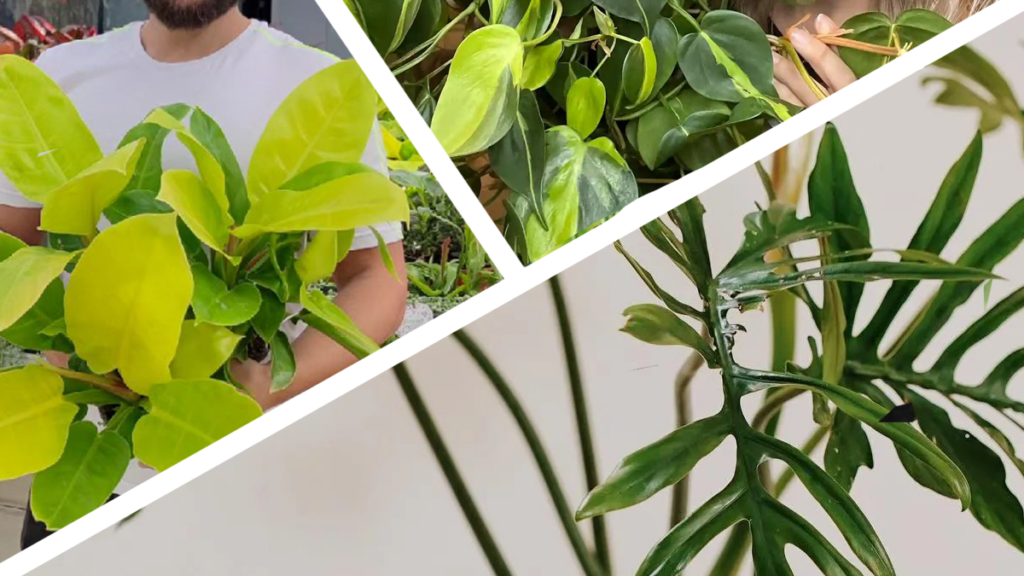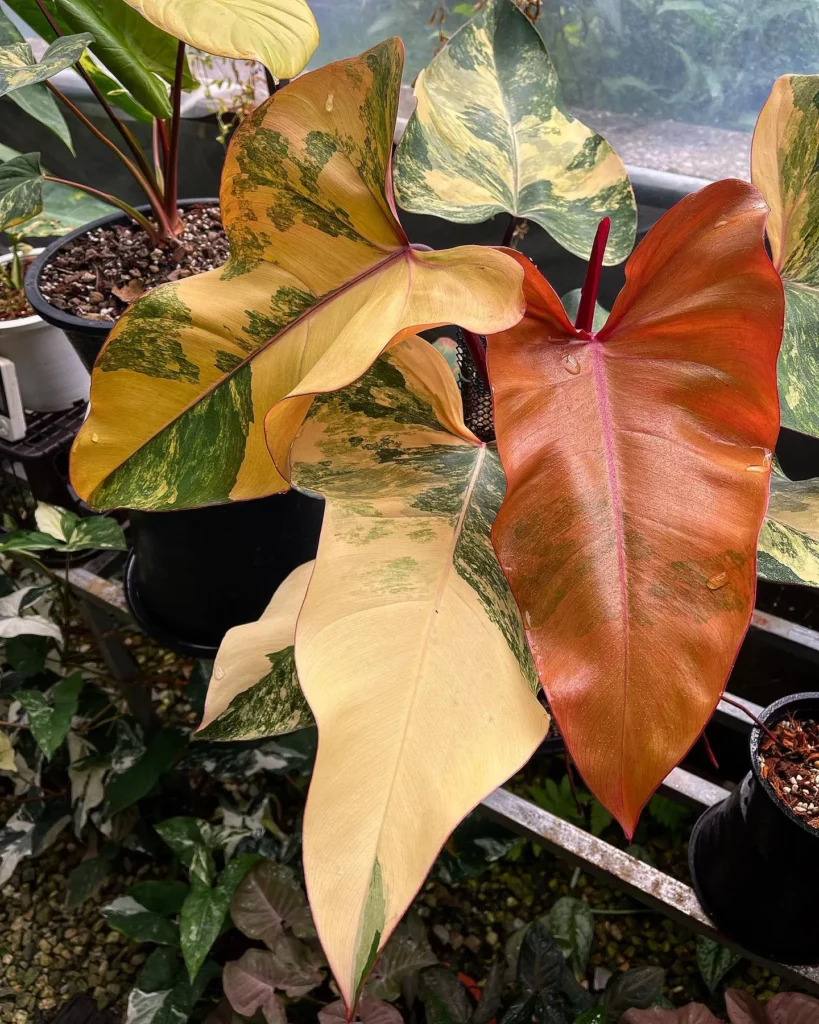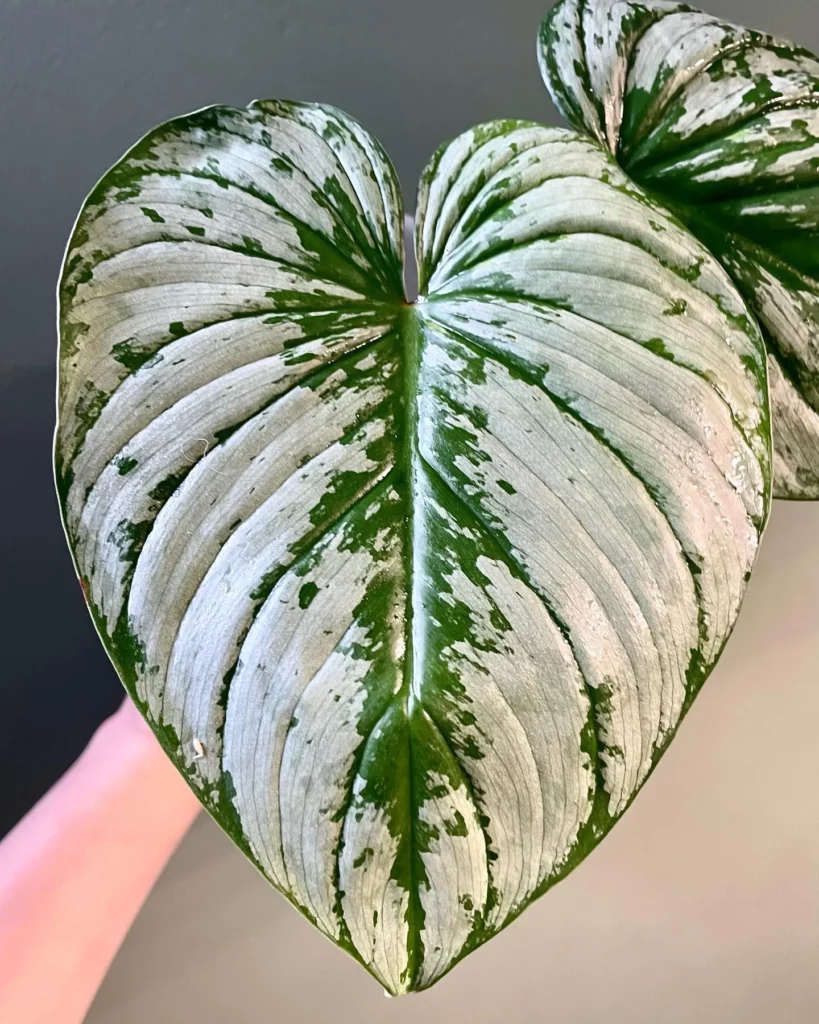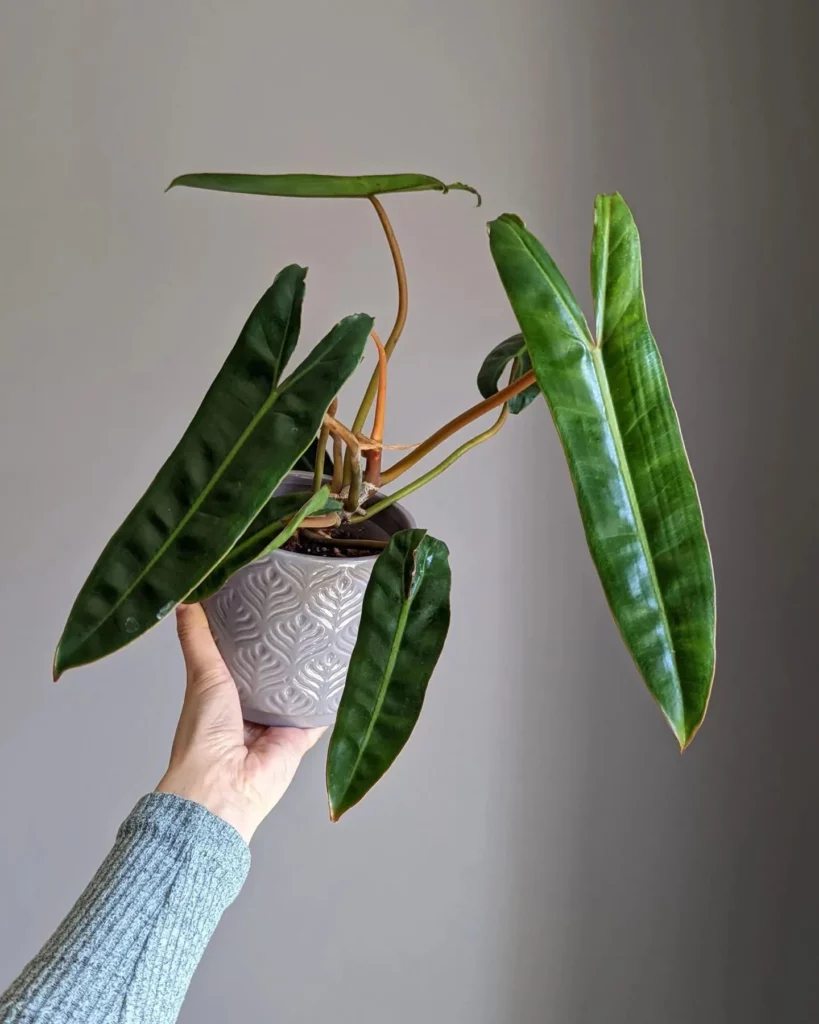Philodendron Squamiferum, also known as the red bristle philodendron. This houseplant features stunning foliage that is sure to catch your eye. The leaves are heart-shaped and can grow up to 12 inches long and wide, creating a bold and tropical look in your home. The upper side of the leaves is a dark green color, while the lower side is light green with a matte finish.
Key Takeaways:
- Philodendron Squamiferum is a unique and popular houseplant known for its tropical-looking foliage and red bristle-covered stems.
- It prefers bright but indirect light and well-drained soil.
- This plant can reach heights of up to 15 feet and is toxic to pets and humans.
- Philodendron Squamiferum is relatively low-maintenance and a great option for both experienced and novice gardeners.
- Exercise caution when handling this plant due to its toxic nature and keep it out of reach of children and pets.
Philodendron Squamiferum Appearance



One of the most captivating features of Philodendron Squamiferum is its red bristles. These bristles cover the plant’s mature hairy stems, giving it a distinct and striking appearance. It’s no wonder this plant is also known as the “red bristle philodendron” and “hairy philodendron.” The combination of its heart-shaped leaves and red bristles makes it a standout addition to any indoor space.
Unique Features of Philodendron Squamiferum:
- Heart-shaped leaves up to 12 inches long and wide
- Dark green upper side of leaves, light green lower side
- Distinctive red bristles covering mature stems
Philodendron Squamiferum Light Requirements



Proper lighting is essential for the health and growth of your Philodendron Squamiferum. This unique plant thrives in bright but indirect light, simulating its natural habitat in the tropical rainforests. When deciding on the perfect spot for your Philodendron Squamiferum, aim for a location that receives bright, filtered light throughout the day.
A few feet away from an east or west-facing window is ideal, as it provides the plant with the right amount of light without exposing it to direct sun rays. If you choose to place your Philodendron Squamiferum near a south-facing window, consider using a sheer curtain to filter and diffuse the intense sunlight. This will protect the plant from leaf scorching and discoloration.
While Philodendron Squamiferum can tolerate lower light conditions, it’s important to strike a balance. Too much shade can lead to leggy growth, less vibrant foliage, and slower development. Therefore, it’s essential to find a location where your Philodendron Squamiferum can benefit from bright, indirect light or partial shade to thrive and display its stunning beauty.
Philodendron Squamiferum Watering
Proper watering is essential for the health and well-being of your Philodendron Squamiferum. As a plant that prefers well-drained soil, it is important to find the right balance when it comes to watering.
Here are some key tips to keep in mind:
- Check the soil moisture: Before watering, always check the moisture level of the soil. Stick your finger about 2 inches into the soil to determine if it is dry. If the soil feels moist, it is best to hold off on watering.
- Water thoroughly but infrequently: When it’s time to water, make sure to do so thoroughly. Water the plant until excess water drains out of the bottom of the pot. This helps ensure that the entire root system gets hydrated. However, it’s important not to overwater, as this can lead to root rot.
- Allow for proper drainage: Philodendron Squamiferum thrives in well-drained soil. Make sure your pot has drainage holes to allow excess water to escape. This will prevent water from sitting stagnant in the pot and potentially causing root problems.
- Observe leaf drooping: Pay attention to the foliage of your plant. If the leaves are drooping, it may be a sign that your Philodendron Squamiferum is not getting enough water. However, be cautious not to overcompensate by overwatering, as this can also cause leaf drooping.
- Adjust watering frequency: The watering needs of your Philodendron Squamiferum may vary depending on factors such as humidity, temperature, and season. During hotter and drier periods, you may need to water more frequently, while in cooler and more humid conditions, less frequent watering may be required.
Philodendron Squamiferum Fertilizing
Proper fertilizing is essential for the healthy growth of Philodendron Squamiferum, as it is a slow-growing plant that benefits from occasional nutrient boosts. When it comes to fertilization, there are several organic options available that can provide the necessary nutrients without harming the plant.
1. Fish Emulsion:
One organic option for fertilizing Philodendron Squamiferum is fish emulsion. This natural fertilizer is rich in essential nutrients and can help promote lush foliage growth. Dilute fish emulsion according to the instructions on the packaging and apply it every 2-4 weeks during the growing season.
2. Water-Soluble or Slow-Release Fertilizers:
Another option is to use water-soluble or slow-release fertilizers specifically formulated for houseplants. These fertilizers release nutrients gradually, providing a steady supply of nourishment to the plant. Follow the instructions on the fertilizer packaging for proper dilution or application rates.
3. Avoid Over-fertilizing:
It is important to be cautious not to over-fertilize Philodendron Squamiferum, as this can lead to fertilizer burn and damage the plant. Always follow the recommended dosage and frequency specified on the fertilizer packaging. Remember, less is often more when it comes to fertilizing houseplants.
Philodendron Squamiferum Potting
Proper potting is essential for the healthy growth and development of Philodendron Squamiferum. This unique plant thrives in a loose, well-draining potting mix that mimics its natural habitat. A recommended potting mix for Philodendron Squamiferum is equal parts orchid bark, perlite, and peaty soil. This combination provides the necessary aeration and drainage for the plant’s roots. If needed, you can add some gravel to the mix to further improve drainage.
When repotting Philodendron Squamiferum, choose a pot that is a couple of inches wider than the current one to allow room for root growth. It’s important not to go too big with the new pot, as this can lead to overwatering and root rot. Repotting is typically necessary every few years, or when you start to see the roots poking out of the drainage holes. This indicates that the plant has outgrown its current container and requires more space.
During the repotting process, gently loosen the root ball and remove any dead or unhealthy roots. Place the plant in the new pot, ensuring that it sits at the same depth as before. Fill the remaining space with the potting mix, firming it gently around the roots. After repotting, water the plant thoroughly to help settle the soil and promote root establishment.
Philodendron Squamiferum Propagation
Propagating Philodendron Squamiferum is a rewarding way to expand your collection or share this unique plant with fellow enthusiasts. One of the most common methods of propagation is through stem cuttings. To do this, select a healthy stem with at least four leaves and locate a node. Nodes are the points on the stem where leaves grow. Using clean, sharp scissors or pruning shears, make a clean cut just below the node.
Once you have your stem cutting, there are two popular methods for rooting it: water propagation and potting soil. In water propagation, place the cutting in a clear jar filled with water, making sure the node is submerged. Change the water every few days to prevent the growth of bacteria or fungi. Alternatively, you can plant the cutting directly into a well-draining potting soil mix. Place the cutting in a small pot filled with moist soil, taking care to position it with the node buried slightly. Keep the soil consistently moist but not overly saturated.
Whether you choose water propagation or potting soil, provide your Philodendron Squamiferum cutting with bright, indirect light and maintain a warm and humid environment. Mist the leaves regularly or use a humidifier nearby to create the ideal conditions for rooting. After a few weeks, you should start to see roots forming. Once the roots reach about an inch in length or the cutting is firmly rooted, it is ready to be repotted into a larger container.
Growing and Pruning Philodendron Squamiferum: Tips for a Beautiful Vining Plant
If you’re a fan of slow-growing, unique houseplants, then Philodendron Squamiferum is a must-have for your collection. This stunning vining plant can add a touch of tropical beauty to any indoor space. However, it’s important to understand how to care for this plant properly to ensure its optimal growth and development.
Growth and Height
Philodendron Squamiferum is known for its slow-growing nature. While it has the potential to reach heights of over 10 feet in ideal conditions, it’s unlikely to reach that height indoors. Regular pruning or pinching back can help control the plant’s growth and keep it more compact and bushy. By removing dead or dying leaves and maintaining its desired shape, you can promote healthy growth and a fuller appearance.
Pruning Techniques
When pruning Philodendron Squamiferum, always use clean and sharp pruning shears or scissors. Start by removing any yellowing or dead leaves, cutting them off at the base of the stem. If you want to control the height of the plant, prune the main stem just above a node, which is where new growth will emerge. You can also pinch back the tips of the stems to encourage bushier growth. Remember to sterilize your pruners before and after each use to prevent the spread of diseases.
Training the Vines
Philodendron Squamiferum is a vining plant, which means it will naturally trail and climb if given the opportunity. You can train the vines to grow in a specific direction by gently guiding them along a trellis, moss pole, or other supportive structures. This will not only help create an aesthetically pleasing display but also prevent the plant from becoming too leggy. Regularly check the vines and adjust their position as needed to maintain the desired shape and appearance.
Philodendron Squamiferum Pests and Diseases
While Philodendron Squamiferum is generally resistant to pests and diseases, there are a few common issues that you may encounter. By being vigilant and taking appropriate action, you can keep your plant healthy and thriving.
Pests
Fungus gnats and spider mites are the most common pests that may affect Philodendron Squamiferum. Fungus gnats are tiny flying insects that are attracted to moist soil. To prevent infestations, avoid overwatering your plant and ensure proper drainage. If you do notice fungus gnats, you can use sticky traps or allow the soil to dry out slightly to discourage their presence.
Spider mites are microscopic pests that feed on the leaves of the plant, causing discoloration and webbing. To control spider mite infestations, regularly inspect your plant for any signs of these pests. If you spot them, rinse the plant with water to remove the mites and use insecticidal soap or neem oil to further treat the affected areas.
Diseases
Yellowing leaves can be a sign of several possible issues, including overwatering, nutrient deficiencies, or root rot. To address yellowing leaves, check the moisture level of the soil and adjust your watering routine accordingly. If the soil is consistently wet, allowing it to dry out can help prevent root rot. If the issue persists, consider adjusting your fertilization schedule or providing additional nutrients to the plant.
Philodendron Squamiferum Toxicity
The Philodendron Squamiferum plant, while beautiful and unique, is important to handle with caution due to its toxic nature. It contains substances that can cause digestive upset, irritation, and other symptoms if ingested. This toxicity applies to both pets and humans, so it is crucial to keep the plant out of reach of children and animals to prevent accidental ingestion.
If any accidental ingestion occurs, it is vital to seek immediate medical attention. The symptoms may vary depending on the individual and the amount ingested. It is always better to be safe and seek medical guidance, even if the symptoms appear mild. Remember to mention the ingestion of Philodendron Squamiferum to healthcare professionals, as it can aid in accurate diagnosis and treatment.
To ensure the safety of yourself, your family, and your pets, it is recommended to wash your hands thoroughly after handling the Philodendron Squamiferum plant. This will help remove any potential residue or allergens that may cause skin irritation or other adverse reactions.
Philodendron Squamiferum: A Unique and Beautiful Plant for Your Home
I can’t help but be captivated by the beauty of Philodendron Squamiferum. This unique houseplant is truly a tropical gem that can bring a touch of elegance to any indoor space.
With its large textured leaves and striking red bristle-covered stems, Philodendron Squamiferum is a standout addition to your indoor decor. Its heart-shaped leaves, which can grow up to 12 inches long and wide, create a lush and vibrant look. The contrast between the dark green upper side and light green lower side of the leaves adds an extra dimension of visual interest.
Not only is Philodendron Squamiferum pleasing to the eye, but it is also relatively easy to care for. As long as you provide it with the right amount of bright indirect light, well-drained soil, and occasional fertilization, it will thrive happily in your home. Just remember to be cautious of its toxicity and keep it out of reach of children and pets.
FAQ
Is Philodendron Squamiferum a unique plant?
Yes, Philodendron Squamiferum is a unique plant known for its tropical-looking foliage and red bristle-covered stems.
How big can the leaves of Philodendron Squamiferum grow?
The leaves of Philodendron Squamiferum can grow up to 18 inches long.
What kind of light does Philodendron Squamiferum prefer?
Philodendron Squamiferum prefers bright but indirect light.
How often should I water Philodendron Squamiferum?
Water Philodendron Squamiferum once the top few inches of soil feel fully dry.
Can Philodendron Squamiferum tolerate lower light conditions?
Yes, Philodendron Squamiferum can tolerate lower light conditions, but too much shade may affect its growth and foliage color.
How often should I fertilize Philodendron Squamiferum?
Philodendron Squamiferum can benefit from occasional fertilization during the spring and summer, about a couple of times a month.
What type of soil is best for Philodendron Squamiferum?
Philodendron Squamiferum thrives in a loose, well-draining potting mix. A recommended blend is equal parts orchid bark, perlite, and peaty soil.
How can I propagate Philodendron Squamiferum?
Philodendron Squamiferum can be easily propagated using stem cuttings placed in water or well-draining potting soil.
How tall can Philodendron Squamiferum grow?
Philodendron Squamiferum can reach heights of over 10 feet, although in indoor conditions it is unlikely to reach that height.
What pests and diseases should I watch out for with Philodendron Squamiferum?
Philodendron Squamiferum can be susceptible to fungus gnats if overwatered and spider mites in dry conditions. Yellowing leaves may indicate root rot and potential pest infestations.
Is Philodendron Squamiferum toxic?
Yes, Philodendron Squamiferum is toxic to both pets and humans. Caution should be exercised when handling and it should be kept out of reach of children and pets.





